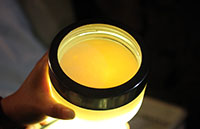New GM rice 'can cut greenhouse emission'
Updated: 2015-07-23 14:10
(Xinhua)
|
|||||||||||
FUZHOU - Scientists from China, Sweden and the United States have developed a high-yielding rice that can reduce methane emissions, a major greenhouse gas blamed for global warming, from paddies.
By inserting a barley gene into rice, Sun Chuanxin and his colleagues created SUSIBA2 Rice, which stores more starch in the section of the rice above ground, according to a paper published on the latest issue of Nature.
This means the grains will have more starch while the root will exude less nutrients that will later be turned into methane by microbes in the soil, Sun, who works with Swedish University of Agricultural Sciences, told Xinhua.
"It solves two major problems mankind faces at one time: environmental degradation and the need for increased grain output, " Wang Feng, co-author of the paper from Fujian Academy of Agricultural Sciences, told Xinhua.
Wang said the rice can cut methane discharge by more than 90 percent during summer and more than half during autumn, as "the rice displays a greater emission reduction effect in high temperatures."
Meanwhile, small-scale trials have also suggested an increased output: a single plant of the new breed has 300 more grains with a starch content 10 percent higher, Wang added.
Wang said the team is working on applications for the breed in different areas, seasons and using different farming techniques. "It's still far away from mass application, but at least we see the light of hope."
Human-induced methane, though less abundant than carbon dioxide in the air, is responsible for 20 percent of the global warming effect. Rice paddies are the largest single source of methane linked to human activity.
According to the Ministry of Agriculture, China produces 209 million tonnes of rice in 2014, or 28 percent of the world's total of 734 million.
Related Stories
Hundreds of Chinese get a taste of GM rice 2015-02-10 07:59
Problematic path to GM rice commercialization 2014-08-27 07:20
No word if GM rice certificates extended 2014-08-19 00:52
China vows zero tolerance for GM rice 2014-07-30 13:52
Li promises carbon emission cuts 2015-07-01 06:59
Beijing to implement new air pollutant emission standards 2015-06-12 15:07
Today's Top News
Greek parliament passes crucial bailout bill
Shanghai says no futures trading manipulation in FTZ
'Spartans' detained by Beijing police for disturbing order
More Chinese companies become world top 500
Another month, another global heat record broken
Forbidden City enters Secret Garden for different shade
Chinese soccer player Zhang joins Spanish club on loan
Navy starts exercise in S. China Sea
Hot Topics
Lunar probe , China growth forecasts, Emission rules get tougher, China seen through 'colored lens', International board,
Editor's Picks

|

|

|

|

|

|






